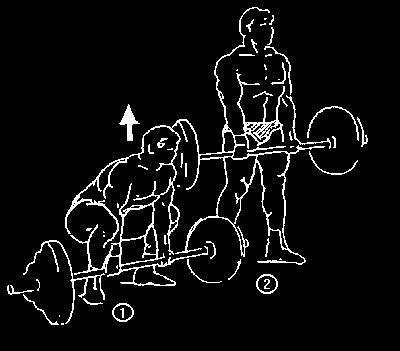

![]()
There are three basic lifts in
powerlifting and the order of events is squat, benchpress, and deadlift. In the
squat and benchpress, the head referee gives a start signal. Causes for
disqualification are:
1. Inappropriate attire, a one piece suit is
required
2. Unacceptable bandaging or wraps or a support
belt wider than 10 cm
The Squat
1) The lifter approaches the bar
resting on heightened racks facing the audience and judges. The
lifter must then take the bar on the back of his shoulders and move away from the racks in
an upright position.
2) When the lifter is in a stable position (no movement of the feet is allowed until
the lift is completed) and the head judge should call "Squat" and will move his
hand downwards. The lifter must sit down to a required depth and stand up without
any assistance to his original standing/upright position.
3) The lifter must wait for the head judge to call "Rack" and demonstrate
a backward movement of the hand, until the bar can be replace on the racks. Spotters
may assist to return the bar back to the racks.
4) The lifter is then judged on the lift - two or more red lights means the lift
does not count.
Causes for Disqualification in the
Squat
1) Failure to observe head
referee's signals at the start or on completion of the lift.
2) Double bouncing or more than one recovery attempt at the bottom of the lift.
3) Failure to assume an upright position with the
knees locked either at the start or end of the lift.
4) Movement of the feet in any direction during the lift.
5) Failure to reach the prescribed depth at the bottom of the lift. (Refer diagrams 1, 2, 3 and 4 below).
6) Moving the position of the hands or the bar during the lift.
7) Spotters touching the bar during the lift.
8) Contact of elbows or upper arms with legs.
9) Failure to make a bona fide attempt to return the bar to the racks.
10) Intentional dropping or dumping of the bar.

A) Top of the knees.
B) Top surface of the legs at the hip joint.
Diagram 4 shows a lifter just below parallel. Point "B" the top surface of the legs at the hip joint below point "A" the top of the knees.
1) The lifter approaches the bench with the top of the bench facing the audience and the judges.
2) The lifter must lie backwards with the head, shoulders and buttocks in contact with the bench. The lifter receives the bar at arm's length from the spotters.
3) On receiving a command from the head judge to "Start", the bar is brought down onto the chest, paused and then it is pressed back to the starting position.
4) The head judge then gives the command " rack" with a movement of the hand backwards. The bar is then returned to the bench racks.
5) The lifter is then judged on the lift.
1) Failure to observe the referee's signals.
2) Any change in the elected position of the shoulders, head, raising of buttocks, lateral movement of hands, or excessive movement of the feet during the lift itself.
3) Inadequate pause of the bar on the chest as well as heaving or bouncing the bar off the chest.
4) Allowing the bar to sink into the chest on the upward press.
5) Uneven extension of the arms during the lift.
6) Any downward motion of the bar on the upward press.
7) Contact with the bar by the spotters during the lift.
8) Any contact with the lifters shoes on the bench during the lift.
9) Deliberate contact with the uprests of the bench and the bar in order to assist the lift.
10) Failure of the centre spotter to give the central referee a clear view.
1) The bar is laid horizontally facing the audience and the judges.
2) The lifter comes to the bar and picks it up in one continuous movement until he is in an upright position with his shoulders locked.
3) The head judge will then signal "Down" with his hand moving downwards. The lifter must return the bar to the ground without dropping the bar.
4) The lifter is judged on the lift.
1) Any downward movement of the bar before the lifter reaches an erect position.
2) Failure to stand erect.
3) Failure to knock the knees straight at the completion of the lift.
4) Supporting the bar on the thighs during the performance of the lift. This is defined as a body position adopted by the lifter that could not be maintained without the counter-balance of the weight being lifted.
5) Movement of the feet in any direction during the lift, although. rocking on the heels is permitted.
6) Lowering of the bar before receiving the head judge's signal.
7) Allowing the bar to return to the platform without maintaining control with both hands.
